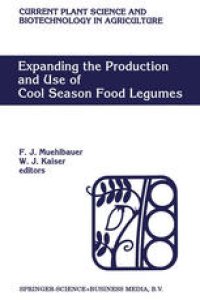
Ebook: Expanding the Production and Use of Cool Season Food Legumes: A global perspective of peristent constraints and of opportunities and strategies for further increasing the productivity and use of pea, lentil, faba bean, chickpea and grasspea in different f
- Tags: Plant Sciences, Plant Physiology, Ecology
- Series: Current Plant Science and Biotechnology in Agriculture 19
- Year: 1994
- Publisher: Springer Netherlands
- Edition: 1
- Language: English
- pdf
The goal of the Second International Food Legume Research Conference held in Cairo, Egypt was to build on the success of the first conference held nearly 6 years earlier at Spokane, Washington, USA. It was at that first conference where the decision was made to hold the second Conference in Egypt and so near the ancestral home of these food legume crops. It has been a long held view that the cool season food legumes had their origin in the Mediterranean basin and the Near-east arc, and there is little doubt that food legumes were a staple food of the ancient Egyptian civilization. The cool season food legumes have the reputation for producing at least some yield under adverse conditions of poor fertility and limited moisture, i. e. , in circumstances where other crops are likely to fail completely. Yields of cool season food legumes are particularly poor in those regions where they are most important to local populations. The influx of more profitable crops such as wheat, maize, and soybeans have gradually relegated the food legumes to marginal areas with poor fertility and limited water which exposes them to even greater degrees of stress. In the past two decades, production of food legumes has declined in most of the developing countries while at the same time it has expanded greatly in Canada, Australia, and most notably in Turkey.
The Second International Food Legume Research Conference (IFLRC-II) was held from 12--16 April 1992 in Cairo, Egypt. Five cool season food legume crops were included in the deliberations: pea (Pisum sativum), lentil (Lens culinaris), faba bean (Vicia faba), chickpea (Cicerarietinum), and grasspea (Lathyrus sativus). The principal objectives of IFLRC-II were to review and assess recent results from national and international research programs on cool season food legumes and to develop strategies for increasing the productivity, improving the quality and extending the use of these crops in different farming systems. Topics in both basic and applied research were addressed and multidisciplinary research efforts were emphasized.
The papers published here are organized according to subject areas: Processing and Animal Feeds; Climate Change and Biotic and Abiotic Stresses; Host Plant Resistance to Manage Biotic Stresses; Policy Incentives; Breeding Methods and Selection Indices; Infrastructural Support; Cool Season Food Legume Breeding; Management to Control Biotic and Abiotic Stresses; Biotechnology and Gene Mapping; Crop Physiology and Productivity; and Farmers' Constraints and On-Farm Research. Sessions devoted to Regional Discussion Groups and to the Continuation of the IFLRC Concept were also included. A Conference Summary is presented by Professor Eric Roberts.